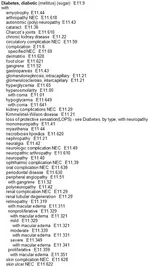When “With” Assumes a Causal Relationship
ICD-10-CM guidelines, Section I. A.15, says, “The classification presumes a causal relationship between the two conditions linked by these terms [i.e., “with”] in the Alphabetic Index or Tabular List.” In other words, you may presume a relationship between two conditions if those conditions are linked within the ICD-10-CM Alphabetic Index or Tabular List — even if documentation does not explicitly state that the two conditions are related.
Make the Connection “With” Causal Relationships
When diagnoses are linked by “with,” ICD-10-CM presumes a causal relationship, but should you? There are 11 possible definitions of the word “with,”
The ICD-10-CM Official Guidelines for Coding and Reporting presumes a causal relationship between two conditions when they are linked with the terms “with” or “in.” These terms should be interpreted to mean “associated with” or “due to” when they appear in a code title, the Alphabetic Index or an instructional note in the tabular list.1 This guideline indicates that certain conditions should be coded as related even in the absence of documentation explicitly linking them. However, if documentation clearly states that the conditions are unrelated, then each condition should be coded separately. For conditions not linked by these relational terms in the classification, medical record documentation must specifically link the two conditions in order to code them as related. Conditions that have a causal relationship often map to a combination code, in which a single code represents two diagnoses or a diagnosis with an associated manifestation and/or complication.
Diabetes mellitus with complication The combination code for diabetes includes the type of diabetes, the body system that is affected and the specific complication affecting that body system. There is an assumed cause-and-effect relationship between diabetes and certain conditions (such as but not limited to: cataract, dermatitis, gastroparesis, chronic kidney disease, osteomyelitis, retinopathy and [poly]neuropathy) as these specific conditions are listed under the term “with” in the Alphabetic Index.2 For example, the documentation does not need to contain a link between the diagnosis of diabetes and neuropathy in order to assign code E11.40 — type 2 diabetes mellitus with diabetic neuropathy. However, if diabetes is not the underlying cause of neuropathy, it should be documented as such and, therefore, not coded as a diabetic complication.
Hypertension, heart and kidney disease The classification also presumes a causal relationship between hypertension and certain heart and/or kidney diseases. If a heart condition (such as but not limited to: cardiomegaly, heart failure, myocardial degeneration and myocarditis) is documented with hypertension, a combination code from category I11 — hypertensive heart disease — should be reported. If heart failure is present, documentation needs to detail the type of heart failure in order to assign the most specific code from category I50 — heart failure. If chronic kidney disease is documented with hypertension, a combination code from I12 — hypertensive chronic kidney disease — should be reported. Documentation needs to identify the stage as 1-5 or end stage renal disease (ESRD) in order to report an additional code from category N18 — chronic kidney disease. If the patient is currently receiving dialysis, it would be appropriate to also code Z99.2 — dependence on renal dialysis. If hypertension, heart failure and chronic kidney disease are all documented, use a combination code from category I13 — hypertensive heart and chronic kidney disease. These are just a few examples of conditions that have an assumed causal relationship in ICD-10-CM.
Guideline I. A. 15, allowing presumptive linkage for code titles sporting “with” or “in,” was most welcome.
The word “with” or “in” (“in” first appeared in the 2018 Guidelines) should be interpreted to mean “associated with” or “due to” when it appears in a code title, the Alphabetic Index, or an instructional note in the Tabular List. The 2019 Guidelines added “either under a main term or subterm” after the Alphabetic Index phrase.
The classification presumes a causal relationship between the two conditions linked by these terms. The conditions are coded as related even in the absence of explicit linkage, unless the documentation clearly states the conditions are unrelated or when there is a superseding guideline demanding explicit linkage (like in sepsis-related organ dysfunction).
Prior to the adjustment in the guidelines, if a provider noted a positive culture in a patient with pneumonia, we would have to query for explicit linkage. We couldn’t presume that the organism was necessarily causal.
However, the Alphabetic Index lists “in (due to)” after the “hypostatic” entry, and then catalogs almost every organism you can imagine. It is our contention that the “with/in” convention renders querying unnecessary. If the provider documents pneumonia and a bacterial (fungal/viral) agent (e.g., pneumonia, cultures positive for E. coli.), these conditions can be inferred as being related; that is, the specific pneumonia would be the correct code. This may land the principal diagnosis into complex pneumonia as opposed to simple pneumonia.

Understanding Presumptive Linkage for Code Titles “With” or “In” – MedLearn Publishing
Sharing insights on assumptive coding When I was a physician advisor, I used to offer a diabetic Charcot joint as an example of why we must be explicit with linkage. Years ago, if a provider listed diabetes mellitus and a Charcot joint (neuropathic osteoarthropathy) as concomitant diagnoses...
Coding Tip of the Month - October 2019
CKD, Hypertension and Diabetes Mellitus: The Third Quarter 2019 Coding Clinic provided additional explanation and interpretation in regard to assuming a cause and affect effect relationship between CKD, hypertension and diabetes mellitus. Although previous advice regarding CKD, hypertension...
Here’s a list of the associated diabetic conditions where the link is assumed in ICD-10-CM:
- amyotrophy
- arthropathy NEC
- autonomic (poly) neuropathy
- cataract
- Charcot’s joints
- chronic kidney disease
- circulatory complication NEC
- complication
- specified NEC
- dermatitis
- foot ulcer
- gangrene
- gastroparalysis
- gastroparesis
- glomerulonephrosis, intracapillary
- glomerulosclerosis, intercapillary
- hyperglycemia
- hyperosmolarity
- with coma
- hypoglycemia
- with coma
- ketoacidosis
- with coma
- kidney complications NEC
- Kimmelsteil-Wilson disease
- loss of protective sensation(LOPS) – see Diabetes, by type, with neuropathy
- mononeuropathy
- myasthenia
- necrobiosis lipoidica
- nephropathy
- neuralgia
- neurologic complication NEC
- neuropathic arthropathy
- neuropathy
- ophthalmic complication NEC
- oral complication NEC
- osteomyelitis
- periodontal disease
- peripheral angiopathy
- with gangrene
- polyneuropathy
- renal complication NEC
- renal tubular degeneration
- retinopathy
- skin complication NEC
- skin ulcer NEC

Coding Diabetes Mellitus with Assumed Conditions
Diabetes continues to be a challenge for coders since the new instruction/guideline was released in 2016.


Hypertension "with" ICD-10 Coding
For dx. purposes, there is an presumed causal relationship between hypertension and heart involvement, and between hypertension and kidney involvement.


